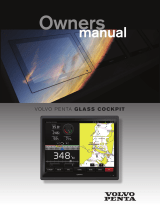
ii GPSMAP 5000 Series Owner’s Manual
Introduction
Table of Contents
Introduction ...............................................i
Tips and Shortcuts ........................................i
Manual Conventions ..................................... i
Quick Links .................................................i
Getting Started .........................................1
Front and Rear Panels ................................1
Turning the Chartplotter On or Off ...............2
Adjusting the Backlight ................................2
Adjusting the Color Mode ............................2
Acquiring GPS Satellite Signals ..................2
Inserting and Removing SD Cards ..............3
Restoring Factory Settings ..........................3
Viewing System Information ........................3
Using the Simulator Mode ...........................3
Understanding the Home Screen ................4
Using Charts ............................................5
Using the Navigation Chart .........................5
Using Mariner’s Eye ....................................9
Using BlueChart g2 Vision.........................10
Using Mariner’s Eye 3D .............................11
Using Fish Eye 3D .....................................12
Changing the Chart Settings .....................13
Using Tracks ..............................................14
Using Fishing Charts .................................15
Enabling High Resolution Satellite
Imagery .....................................................16
Viewing Aerial Photos ................................17
Viewing Current Station Information ..........18
Detailed Road and POI Data .....................18
Using Automatic Guidance ........................18
Using Combinations ..............................19
Where To? ..............................................21
Navigating to a Destination .......................21
Creating and Using Waypoints ..................23
Creating and Using Routes .......................26
Viewing Information ..............................29
Viewing Tide Station Information ...............29
Viewing Current Information ......................29
Viewing Celestial Information ....................30
Viewing User Data .....................................30
Viewing Information on Other Boats ..........32
Viewing Gauges ........................................33
Viewing Fuel Gauges ................................33
Viewing Video ............................................34
Conguring the Unit ..............................35
Conguring System Settings .....................35
Changing Units of Measure .......................35
Conguring Communications Settings ......36
Setting Alarms ...........................................37
Conguring My Boat ..................................39
Conguring Other Boats ............................40
Conguring XM Audio ................................41
Using the Marine Network ....................42
Viewing Connected Garmin Marine
Network Devices .......................................43
Using Radar ...........................................44
Understanding the Cruising Screen ..........45
Changing Radar Settings ..........................48
Using Sonar ...........................................49
Understanding the Full Screen ..................49
Understanding the Split Zoom Screen ......49
Understanding the Split Frequency
Screen .......................................................50
Understanding the Temp Log ....................50
Setting Up Sonar .......................................51
Advanced Sonar Settings ..........................52
Using XM WX Weather
™
and Audio ......53
Using XM WX Weather..............................53
Setting the XM WX Weather Options ........53
Viewing Precipitation Information ..............53
Viewing Forecast Information ....................56
Viewing Sea Conditions.............................57
Viewing Fishing Information ......................57
Viewing Visibility Information .....................58
Viewing Buoy Reports ...............................59
Using XM Audio .........................................60
Appendix ................................................61
Specications ............................................61
Calibrating the Touchscreen ......................62
NMEA 0183 and NMEA 2000 ....................62
Messages and Alarms ...............................64
Product Registration ..................................68
Contact Garmin .........................................68
Declaration of Conformity (DoC) ...............68
Weather Data Warranty .............................68
Software License Agreement ....................69
XM Satellite Radio Service Agreement .....69
Index .......................................................70




























